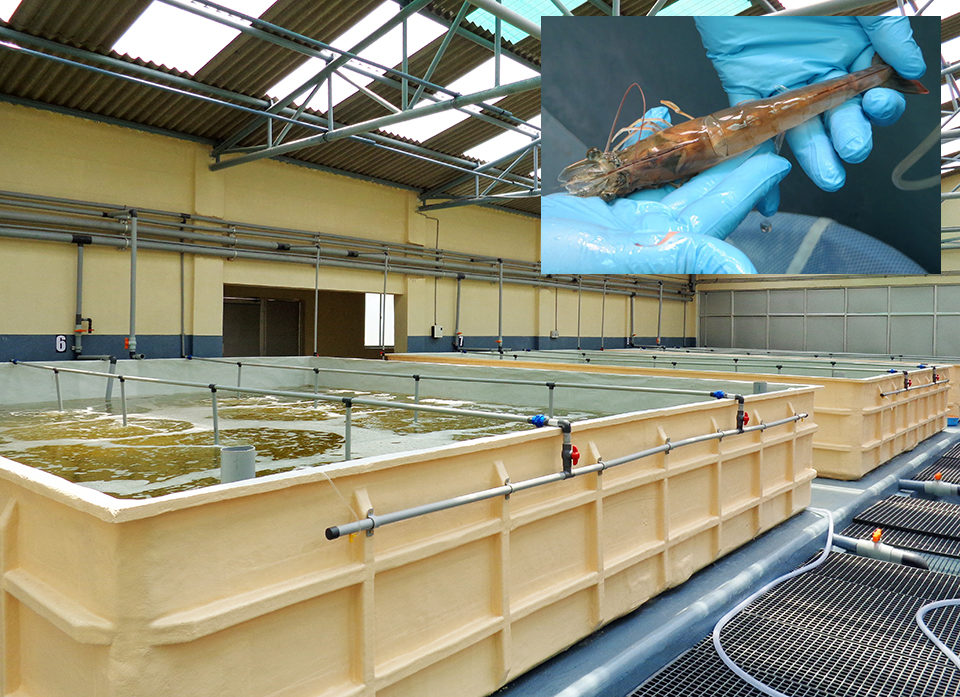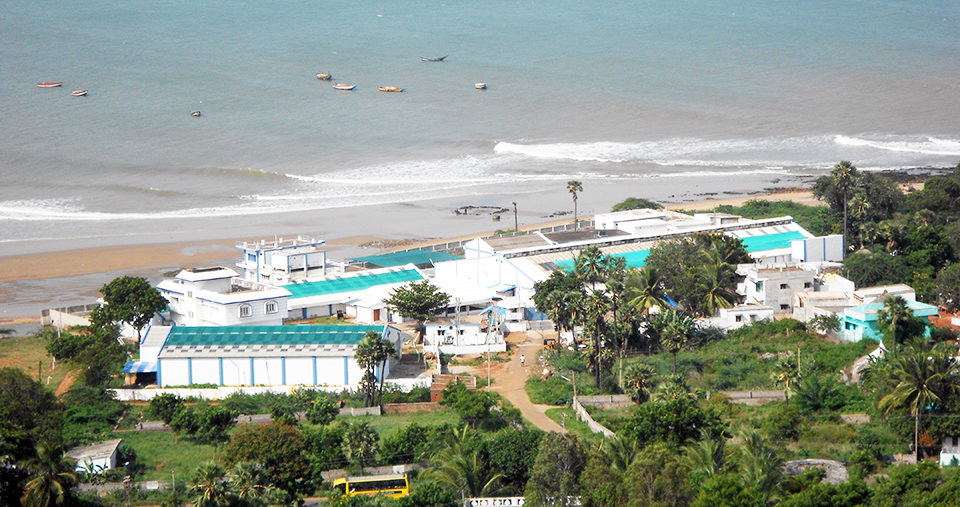Animals are better acclimated to local culture conditions, with reduced stress from long-distance shipment

In 2013, India replaced Thailand as the largest exporter of farmed shrimp to the United States. Although a dramatic decline in shrimp production in Thailand and other Asian countries due to early mortality syndrome (EMS) was the primary cause for this change, India has become a major supplier of farmed shrimp to consumers worldwide. Currently, India is free of EMS, largely due to the implementation of rigorous import restrictions and a state-of-the-art quarantine system aimed at mitigating the spread of shrimp diseases from other countries.
According to the Marine Products Export Development Authority (MPEDA), the value of India’s seafood exports reached U.S. $5.0 billion in 2013-14, up from about $3.5 billion the previous year. Frozen shrimp accounted for 64 percent of the total seafood export value. MPEDA largely attributed the rise in exports to increased production of Pacific white shrimp, Litopenaeus vannamei. Exports of L. vannamei jumped to 175,000 mt in 2013-2014, a 92 percent increase from the previous year’s level.
The continued expansion of L. vannamei farming in India is being supported by a collaborative research project under the leadership and support of MPEDA Chairwoman Leena Nair, IAS, involving the Rajiv Gandhi Centre for Aquaculture (RGCA) functioning under MPEDA (Ministry of Commerce and Industry, Government of India), and the Oceanic Institute (O.I.) of Hawaii Pacific University in the United States.
Collaborative partnership
The project focuses on production of specific-pathogen-free (SPF), selectively bred L. vannamei broodstock that exhibit good reproductive performance, as well as fast growth and high survival on commercial farms in India.
Genetically diverse cohorts of shrimp families produced at O.I.’s Nucleus Breeding Center in Hawaii, USA, are shipped to India for performance evaluations at commercial test farms. After about 70 days of growout, the shrimp are harvested, and performance data are collected and analyzed. Once top-performing families are identified, siblings from those families, which are kept at the O.I. breeding center, are used to produce SPF offspring, which are then shipped as postlarvae to a broodstock production center in India to be grown to broodstock.

Biosecure facilities, best practices
The Andhra Pradesh Shrimp Seed Production, Supply and Research Centre (TASPARC), the broodstock center for this project, is located in Visakhapatnam, Andhra Pradesh, India. Strict biosecurity and implementation of best management practices are critical components of the research collaboration. This effort is supported by the RGCA Aquatic Quarantine Facility for L. vannamei located in Chennai, Tamilnadu, India.
Upon arrival in India, all shrimp are maintained in quarantine for five days, where they are monitored and tested for specific shrimp pathogens. Once shrimp test negative for pathogens, they are transferred to a commercial test farm for field evaluations or TASPARC for grow-out.
To maintain a high level of biosecurity, TASPARC is equipped with both influent and effluent seawater treatment systems that incorporate mechanical filtration, ozone disinfection and ultraviolet disinfection, as well as recirculating culture systems to reduce water exchange. In addition, a pathogen surveillance program ensures the SPF status of all shrimp reared at the facility.
The program performs testing for the presence of white spot syndrome virus, Taura syndrome virus, yellowhead virus, infectious hypodermal and hematopoietic necrosis virus, infectious myonecrosis virus, monodon baculovirus, bacilliform virus, hepatopancreatic parvolike virus, Mourilyan virus and necrotizing hepatopancreatitis virus. Histological analysis is also conducted periodically as a management tool to identify any abnormalities that may indicate poor animal health. Disease testing is conducted by the RGCA diagnostic laboratory in Sirkali, Tamilnadu, India – the only National Accreditation Board for Testing and Calibration Laboratories-accredited aquaculture pathology laboratory in India – and the Aquaculture Pathology Laboratory at the University of Arizona in the United States, an independent laboratory certified by the World Organization for Animal Health (OIE).
Soon after operations began, an independent biosecurity audit and facility evaluation conducted by the University of Arizona determined that TASPARC complied with all biosecurity requirements to prevent the entrance and spread of OIE-listed diseases of penaeid shrimp.
Broodstock production
TASPARC broodstock are reared in a two-phase grow-out system. Postlarvae are grown in phase-1 modules to weights of approximately 15 to 20 g before being transferred to separate phase-2 modules, where shrimp are grown at lower densities to 40 to 50 g. It takes approximately six months to raise the shrimp to broodstock size.
All shrimp-rearing facilities are located within enclosed buildings with various levels of transparent roofing that can be adjusted based on the amount of natural light and temperature. Microalgae are produced on site, and cultures are used to inoculate culture systems and maintain blooms in both phases of grow-out. High-quality shrimp feed imported from the U.S. ensures optimal nutrition during grow-out.
Water quality is closely monitored, and any seasonal environmental fluctuations are kept at a minimum. The facility also includes a broodstock distribution area, where broodstock shrimp are acclimated and packaged for transport to hatcheries in India.
TASPARC began operations in early October 2012, when it received the first batch of SPF L. vannamei postlarvae from O.I. Over the first 18 months of operation, TASPARC produced and distributed over 47,800 SPF L. vannamei broodstock to local hatcheries. To date, over 60 hatcheries in India have received broodstock from TASPARC, and derivative postlarvae have been supplied to farmers in various regions throughout India. The current project has the capacity to produce over 45,000 broodstock annually.
Local hatchery owners and farmers are encouraged to provide feedback on the overall performance of TASPARC broodstock. This information can be used to refine selection goals and provide Indian stakeholders with high-quality shrimp selected for performance in India’s commercial grow-out environments.
Perspectives
In addition to in-country evaluations of shrimp families and related selection efforts, this collaborative project provides the added benefit of in-country grow-out of shrimp broodstock. This allows for better acclimation of broodstock to local culture conditions and reduces the amount of stress imposed by long-distance shipment, both of which can impact the performance of imported broodstock.
Importantly, the broodstock production at TASPARC supports India’s domestic shrimp-farming industry – including small-scale and marginal farmers – by providing SPF L. vannamei broodstock at affordable prices and avoiding high shipping costs associated with importation of broodstock from other countries.
(Editor’s Note: This article was originally published in the January/February 2015 print edition of the Global Aquaculture Advocate.)
Authors
-
Steve M. Arce
Oceanic Institute of Hawaii Pacific University
41-202 Kalanianaole Highway
Waimanalo, Hawaii USA 96795 -
Y. C. Thampi Sam Raj
Rajiv Gandhi Centre for Aquaculture
Shrimp Breeding
Chennai, Tamilnadu, India -
H. Dinesh Kumar
Rajiv Gandhi Centre for Aquaculture
L. vannamei Multiplication Centre
Visakhapatnam, Andhra Pradesh, India -
Dustin R. Moss, Ph.D.
Oceanic Institute of Hawaii Pacific University
41-202 Kalanianaole Highway
Waimanalo, Hawaii USA 96795
Tagged With
Related Posts

Aquafeeds
Biosecurity protocols needed for shrimp feeds, feeding practices
Shrimp aquafeeds – live, fresh or formulated – should not be an entry point of potential pathogens to the shrimp and/or to their culture systems.

Health & Welfare
Genetics key to maximum growth rate for shrimp
Realizing higher growth rates in commercially cultured shrimp has many important benefits, including reducing various risks, cutting costs and increasing economic opportunities. Shrimp genetics primarily determines the amount of additional growth that can be achieved, as shrimp typically reflect their parents’ growth rates.

Responsibility
A look at various intensive shrimp farming systems in Asia
The impact of diseases led some Asian shrimp farming countries to develop biofloc and recirculation aquaculture system (RAS) production technologies. Treating incoming water for culture operations and wastewater treatment are biosecurity measures for disease prevention and control.

Health & Welfare
Aquamimicry: A revolutionary concept for shrimp farming
Aquamimicry simulates natural, estuarine production conditions by creating zooplankton blooms as supplemental nutrition to the cultured shrimp, and beneficial bacteria to maintain water quality. Better-quality shrimp can be produced at lower cost and in a more sustainable manner.


